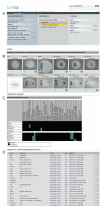A comparative gene expression database for invertebrates
- PMID: 21861937
- PMCID: PMC3180427
- DOI: 10.1186/2041-9139-2-17
A comparative gene expression database for invertebrates
Abstract
Background: As whole genome and transcriptome sequencing gets cheaper and faster, a great number of 'exotic' animal models are emerging, rapidly adding valuable data to the ever-expanding Evo-Devo field. All these new organisms serve as a fantastic resource for the research community, but the sheer amount of data, some published, some not, makes detailed comparison of gene expression patterns very difficult to summarize - a problem sometimes even noticeable within a single lab. The need to merge existing data with new information in an organized manner that is publicly available to the research community is now more necessary than ever.
Description: In order to offer a homogenous way of storing and handling gene expression patterns from a variety of organisms, we have developed the first web-based comparative gene expression database for invertebrates that allows species-specific as well as cross-species gene expression comparisons. The database can be queried by gene name, developmental stage and/or expression domains.
Conclusions: This database provides a unique tool for the Evo-Devo research community that allows the retrieval, analysis and comparison of gene expression patterns within or among species. In addition, this database enables a quick identification of putative syn-expression groups that can be used to initiate, among other things, gene regulatory network (GRN) projects.
Figures







Similar articles
-
Leeches of the genus Helobdella as model organisms for Evo-Devo studies.Theory Biosci. 2015 Dec;134(3-4):93-104. doi: 10.1007/s12064-015-0216-4. Epub 2015 Nov 23. Theory Biosci. 2015. PMID: 26596996
-
GigaTON: an extensive publicly searchable database providing a new reference transcriptome in the pacific oyster Crassostrea gigas.BMC Bioinformatics. 2015 Dec 2;16:401. doi: 10.1186/s12859-015-0833-4. BMC Bioinformatics. 2015. PMID: 26627443 Free PMC article.
-
The future of Cochrane Neonatal.Early Hum Dev. 2020 Nov;150:105191. doi: 10.1016/j.earlhumdev.2020.105191. Epub 2020 Sep 12. Early Hum Dev. 2020. PMID: 33036834
-
Transcriptomics of developing embryos and organs: A raising tool for evo-devo.J Exp Zool B Mol Dev Evol. 2015 Jun;324(4):363-71. doi: 10.1002/jez.b.22595. Epub 2014 Nov 11. J Exp Zool B Mol Dev Evol. 2015. PMID: 25387424 Review.
-
Comparative Transcriptomes and EVO-DEVO Studies Depending on Next Generation Sequencing.Comput Math Methods Med. 2015;2015:896176. doi: 10.1155/2015/896176. Epub 2015 Oct 12. Comput Math Methods Med. 2015. PMID: 26543497 Free PMC article. Review.
Cited by
-
A computational approach towards a gene regulatory network for the developing Nematostella vectensis gut.PLoS One. 2014 Jul 30;9(7):e103341. doi: 10.1371/journal.pone.0103341. eCollection 2014. PLoS One. 2014. PMID: 25076223 Free PMC article.
-
Mechanical forces as information: an integrated approach to plant and animal development.Front Plant Sci. 2014 Jun 10;5:265. doi: 10.3389/fpls.2014.00265. eCollection 2014. Front Plant Sci. 2014. PMID: 24959170 Free PMC article. Review.
-
A framework for the establishment of a cnidarian gene regulatory network for "endomesoderm" specification: the inputs of ß-catenin/TCF signaling.PLoS Genet. 2012;8(12):e1003164. doi: 10.1371/journal.pgen.1003164. Epub 2012 Dec 27. PLoS Genet. 2012. PMID: 23300467 Free PMC article.
-
Characterization of Morphological and Cellular Events Underlying Oral Regeneration in the Sea Anemone, Nematostella vectensis.Int J Mol Sci. 2015 Dec 1;16(12):28449-71. doi: 10.3390/ijms161226100. Int J Mol Sci. 2015. PMID: 26633371 Free PMC article.
-
Nematostella vectensis, an Emerging Model for Deciphering the Molecular and Cellular Mechanisms Underlying Whole-Body Regeneration.Cells. 2021 Oct 8;10(10):2692. doi: 10.3390/cells10102692. Cells. 2021. PMID: 34685672 Free PMC article. Review.
References
Grants and funding
LinkOut - more resources
Full Text Sources
Research Materials
Miscellaneous

